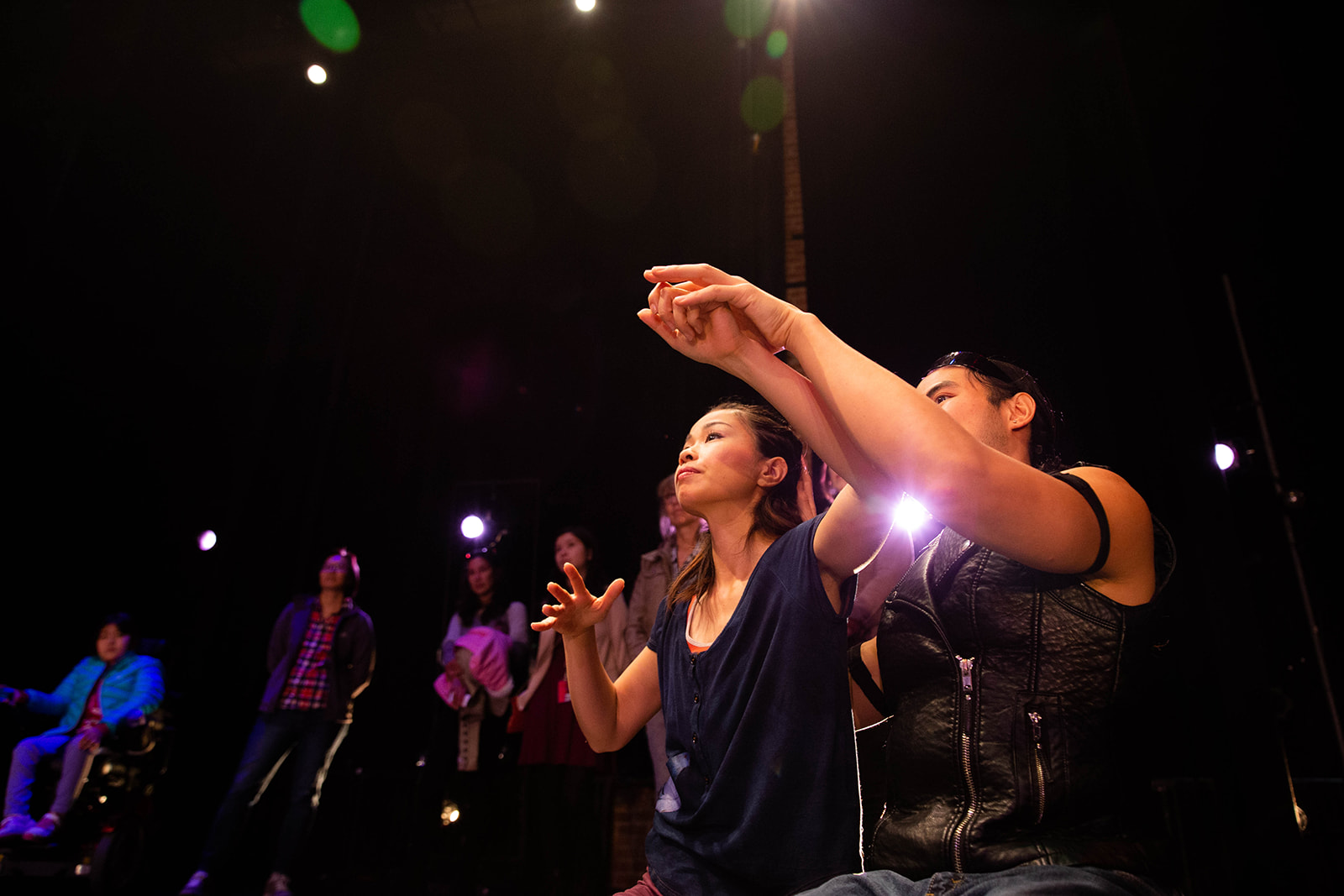
Yuko Monden Juma leading pre-show touch tour, photo by Adriana Oyarzum
[ID: Former AXIS Dancer Yuko leads an audience member through a pre-show touch tour of our 2019 Home Season. Using her arms, she guides the person through upper body movement using the sensation of touch]
How can we shift the way we think about accessibility in the arts, from merely accommodating differences to celebrating and integrating them into the very fabric of the creative process? At the heart of AXIS Dance Company’s mission lies the powerful belief that dance is a vehicle for change. It has the capacity to challenge perceptions, ignite conversations, and ultimately redefine what is possible for disabled artists in the broader arts community. Through our performances and educational programs, AXIS extends this belief into the lives of others, creating a ripple effect that reaches far beyond the stage.
Since its founding in 1987, AXIS Dance Company has become a trailblazer in the world of inclusive dance, proving that the transformative power of movement knows no boundaries. Currently led by Artistic Director Nadia Adame and Managing Director Danae Rees, AXIS has grown into one of the nation’s most celebrated ensembles, showcasing a dynamic mix of disabled, non-disabled, d/Deaf, and neurodiverse professional performers. Based in the Bay Area, California, AXIS has not only been a force in redefining what dance can be but also in changing the very perception of disability within the arts.
One of the most recent contributions from AXIS is our Access Guide to Presenting and Touring the Performing Arts, a groundbreaking resource designed to make performance spaces truly accessible to all. The idea for the guide emerged out of a simple but urgent need: to have performance spaces be accessible not only to our audiences but to the admin, tech, and artists themselves. We’ve often found that when we work with venues to address accessibility, we see positive changes in the short term. When our team collaborates with venue staff—administrators, artists, and technical teams—everyone gets involved and learns about how they can make the space more inclusive. But here’s the problem: many venues only apply these changes when we’re there performing. Once we leave, the lessons learned seem to fade. If we return to those same venues after a few years, we often find ourselves repeating the same work to make the space accessible again. Our Access Guide is designed to break this cycle, ensuring that the work we’ve done has lasting impact.
This resource, available as a fully accessible website, is the result of years of collaboration with disabled artists, architects, presenters, researchers, and activists from across the country. It’s not just about removing physical barriers; it’s about rethinking what accessibility truly means in the performing arts. We want to spark a shift—toward a more inclusive, thoughtful understanding of access that goes beyond the basics and embraces the full spectrum of needs and experiences.
Rather than simply offering a checklist of accommodations, the Access Guide takes a comprehensive approach to accessibility, considering physical, emotional, cultural, and social elements that foster a truly inclusive environment. It’s a roadmap for creating spaces where disabled artists can not only exist but thrive—an act that goes beyond accommodation into the realm of equity, representation, and belonging.
Based on this approach, the Access Guide is rooted in a set of principles that reflect the values that AXIS holds dear:
- Accessibility is Artful: For many disabled artists, access features such as captions, ASL interpretation, or visual descriptions are not just additional elements—they are integral parts of the creative process, woven into the fabric of the work itself. Accessibility can and should be part of the artistic vision.
- Accessibility is Community Care: True accessibility isn’t just about meeting basic needs; it’s about mutual care and support. Disabled people have often been the ones leading efforts to care for each other, and that spirit of community mutual aid is at the heart of creating access that is genuinely meaningful.
- Accessibility is Deaf-Centric: Good access design must center Deaf artists and their communities. Information and resources need to be delivered in ways that meet the linguistic and cultural needs of Deaf people, ensuring they are not left out of the conversation.
- Accessibility is Safety: Ensuring the safety of disabled artists—especially in emergency situations—is a cornerstone of inclusive arts practices. Disabled artists are not inherently more fragile, but safety protocols must be robust, thorough, and reflective of the unique needs of disabled individuals.
- Accessibility is Relationship-Building: Authentic accessibility comes from building real relationships. Understanding the individual preferences of disabled artists and respecting the nuances of their communication styles—often influenced by concepts like Crip time—is essential to creating accessible spaces.
- Accessibility is Belonging: The feeling that you are expected—that your presence is not only allowed but celebrated—is the hallmark of a well-designed accessible experience. Inclusivity requires consistent practice, responsibility, and a long-term commitment to creating spaces where everyone belongs.
- Accessibility is Engaging: Accessibility must be integrated at every stage of a project—during the planning, the performance, and beyond. When access is thoughtfully designed, it enhances the experience for everyone, leaving lasting impressions on both the artists and the audience.
- Accessibility is Action: Accessibility is not something that happens automatically. It requires active champions of inclusivity—those willing to break old habits, challenge norms, and continually advocate for change. And once changes are made, they require ongoing attention and care.
- Accessibility is Evolving: Just as art evolves, so too does accessibility. New innovations, technologies, and strategies are constantly emerging, and staying up to date requires an ongoing, dynamic approach to ensuring access.
At AXIS, accessibility is not an afterthought. It is woven into the fabric of our mission, our work, and our community. The creation of the Access Guide represents a critical move toward ensuring that disabled artists are empowered to lead and innovate. As we continue to collaborate with artists, venues, and educational institutions, AXIS is paving the way for a future where dance and performing arts are accessible, inclusive, and equitable for all.
In a world that often overlooks the talents of disabled individuals, AXIS Dance Company remains a powerful force in showing that true inclusivity benefits everyone—and that artistic excellence is at its best when it embraces the diversity of all bodies and experiences.
—For more information about the Access Guide, visit https://accessguide.axisdance.org/
This article appeared in the Winter 2025 issue of In Dance.


